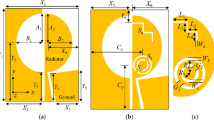Abstract
In this paper, we study optimal precoding matrix for spectrum sharing multiple-input multiple-output (MIMO) cognitive multiple-relay systems. Our aim is to maximize the system capacity subject to the total relay transmit power constraint and the interference power constraint at the primary user. For general case, all the nodes have multiple antennas. The precoder design problem is a non-convex problem. Currently there is no global optimal solution for it. We propose a suboptimal algorithm in which we first transform the original precoder design problem to a unitary matrix constrained problem. And then, we develop a modified Riemannian steepest descent algorithm (MRSDA) to solve it. For the special case that the secondary user has a single antenna and other nodes have multi-antennas, we propose an optimal solution based on rank-one decomposition theorem to transform the original problem into a semidefinite programming. Simulation results demonstrate the effectiveness of the proposed precoding matrix design algorithms.







Similar content being viewed by others
Notes
The imperfect CSI case will be considered in our future work.
We adopt the assumption that the interference from the PU to SU is neglected as [4–12]. In IEEE 802:22 standard, the secondary wireless regional area network (WRAN) is located far away from the primary transmitter and hence the interference from the primary transmitter can be neglected at the secondary receiver.
References
Haykin, S. (2005). Cognitive radio: Brain-empowered wireless communications. IEEE Journal on Selected Areas in Communications, 23(2), 201–220.
Ghasemi, A., & Sousa, E. S. (2007). Fundamental limits of spectrum-sharing in fading environments. IEEE Transactions on Wireless Communications, 6(2), 649–658.
Luo, L., Zhang, P., Zhang, G., & Qin, J. (2011). Outage performance for cognitive relay networks with underlay spectrum sharing. IEEE Communications Letters, 15(7), 710–712.
da Costa, D. B., Aïssa, S., & Cavalcante, C. C. (2012). Performance analysis of partial relay selection in cooperative spectrum sharing systems. Wireless Personal Communications, 64(1), 79–92.
Ho-Van, K. (2012). Exact outage probability of underlay cognitive cooperative networks over Rayleigh fading channels. Wireless Personal Communications. doi:10.1007/s11277-012-0742-z.
Li, L., Zhao, X., Xu, H., et al. (2011). Simplified relay selection and power allocation in cooperative cognitive radio systems. IEEE Transactions on Wireless Communications, 10(1), 33–36.
Zarifi, K., Affes, S., & Ghrayeb A. (2011). Joint source power control and relay beamforming in amplify-and-forward cognitive networks with multiple source-destination pairs. In Proceedings of IEEE ICC (pp. 1–6). Kyoto: Japan, June 5–9, 2011.
Duong, T. Q., Bao, V. N. Q., & Zepernick, H.-J. (2011). Exact outage probability of cognitive AF relaying with underlay spectrum sharing. Electronic Letters, 47(17), 1001–1002.
Zhang, R., & Liang, Y. C. (2008). Exploiting multi-antennas for opportunistic spectrum sharing in cognitive radio networks. IEEE Journal of Selected Topics in Signal Processing, 2(1), 88–102.
Zhang, R., Liang, Y. C., & Cui, S. (2010). Dynamic resource allocation in cognitive radio networks: A convex optimization perspective. IEEE Signal Processing Magazine, 27(3), 102–114.
Li, Q., Luo, L., & Qin, J. (2012). Optimal relay precoder for non-regenerative MIMO cognitive relay systems with underlay spectrum sharing. Electronics Letters, 48(5), 295–297.
Jitvanichphaibool, K., Liang, Y. C., & Zhang, R. (2009). Beamforming and power control for multi-antenna cognitive two-way relaying. In Proceedings of IEEE WCNC (pp. 1–6). Budapest: Hungary, April 5–8, 2009.
Mu, H., Tugnait, J. K. (2012). MSE-based source and relay precoder design for cognitive radio multiuser two-way relay systems. In Proceedings of IEEE WCNC (pp. 742–747).
Shi, H., Abe, T., Asai, T., & Yoshino, H. (2007). Relaying schemes using matrix triangularization for MIMO wireless networks. IEEE Transactions on Communications, 55(9), 1683–1688.
Guan, W., Luo, H., & Chen, W. (2008). Linear relaying scheme for MIMO relay system with QoS requirements. IEEE Signal Processing Letters, 15, 697–700.
Lee, K. J., Sung, H., Park, E., & Lee, I. (2010). Joint optimization for one and two-way MIMO AF multiple-relay systems. IEEE Transactions on Wireless Communications, 9(12), 3671–3681.
Li, Q., Huang, J., Zhang, G., & Qin, J. (2012). Nearly optimal linear transceiver design for amplify-and-forward MIMO multiple-relay systems under MMSE criterion. International Journal of Communication Systems. doi:10.1002/dac.2430.
Hu, C.-C., Liang, W.-Y., & Li, G.-Y. (2012). MMSE-based transceiver design for distributed MIMO amplify-and-forward cooperative networks in correlated channels. International Journal of Communication Systems. doi:10.1002/dac.2429.
Lutkepohl, H. (1996). Handbook of matrices. Chichester: Wiley.
Hyvärinen, A., Karhunen, J., & Oja, E. (2001). Independent component analysis. New York: Wiley.
Wang, L., Karhunen, J., & Oja, E. (1995). A bigradient optimization approach for robust PCA, MCA and source separation. In Proceedings of IEEE International Conference on Neural Networks (pp. 1684–1689). Australia.
Manton, J. H. (2002). Optimization algorithms exploiting unitary constraints. IEEE Transactions on Signal Processing, 50, 635–650.
Abrudan, T. E., Eriksson, J., & Koivunen, V. (2008). Steepest descent algorithms for optimization under unitary matrix constraint. IEEE Transactions on Signal Processing, 56(3), 1134–1147.
Boyd, S., & Vandenberghe, L. (2004). Convex optimization. Cambridge: Cambridge University Press.
Bertselas, D. P. (1999). Nonlinear programming (2nd ed.). Belmont, MA: Athena Scientific.
Ai, W., Huang, Y., & Zhang, S. (2011). New results on Hermitian matrix rank-one decompostion. Mathematical Programming, 128, 253–283.
Magnus, J., & Neudecker, H. (2007). Matrix differential calculus with applications in statistics and econometrics. New York: Wiley.
Li, Q., Zhang, Q., Feng, R., Luo, L., & Qin, J. (2013). Optimal relay selection and beamforming in MIMO cognitive multi-relay networks. IEEE Communications Letters, 17(6), 1188–1191.
Acknowledgments
This work was supported by the National Natural Science Foundation of P. R. China (61472458, 61202498, 61173148).
Author information
Authors and Affiliations
Corresponding author
Rights and permissions
About this article
Cite this article
Li, Q., Feng, R. & Qin, J. Linear Relaying Design for Spectrum Sharing Non-regenerative MIMO Cognitive Multiple-Relay Systems. Wireless Pers Commun 81, 1045–1062 (2015). https://doi.org/10.1007/s11277-014-2170-8
Published:
Issue Date:
DOI: https://doi.org/10.1007/s11277-014-2170-8




